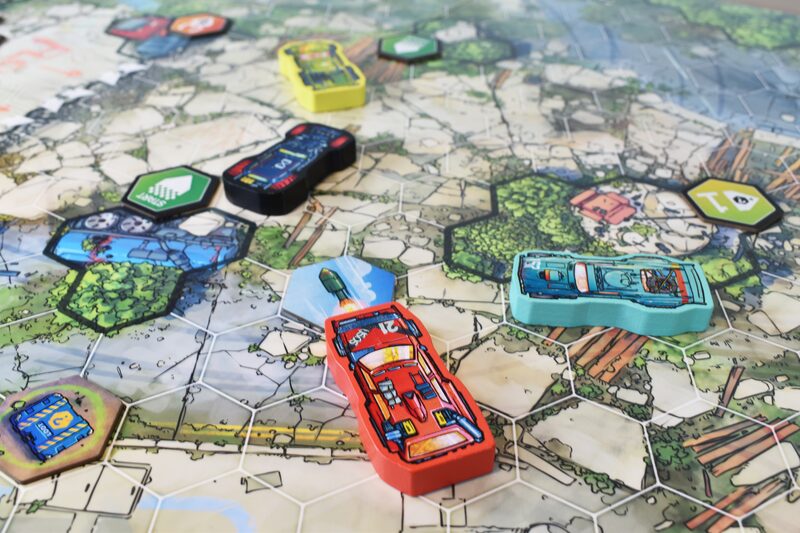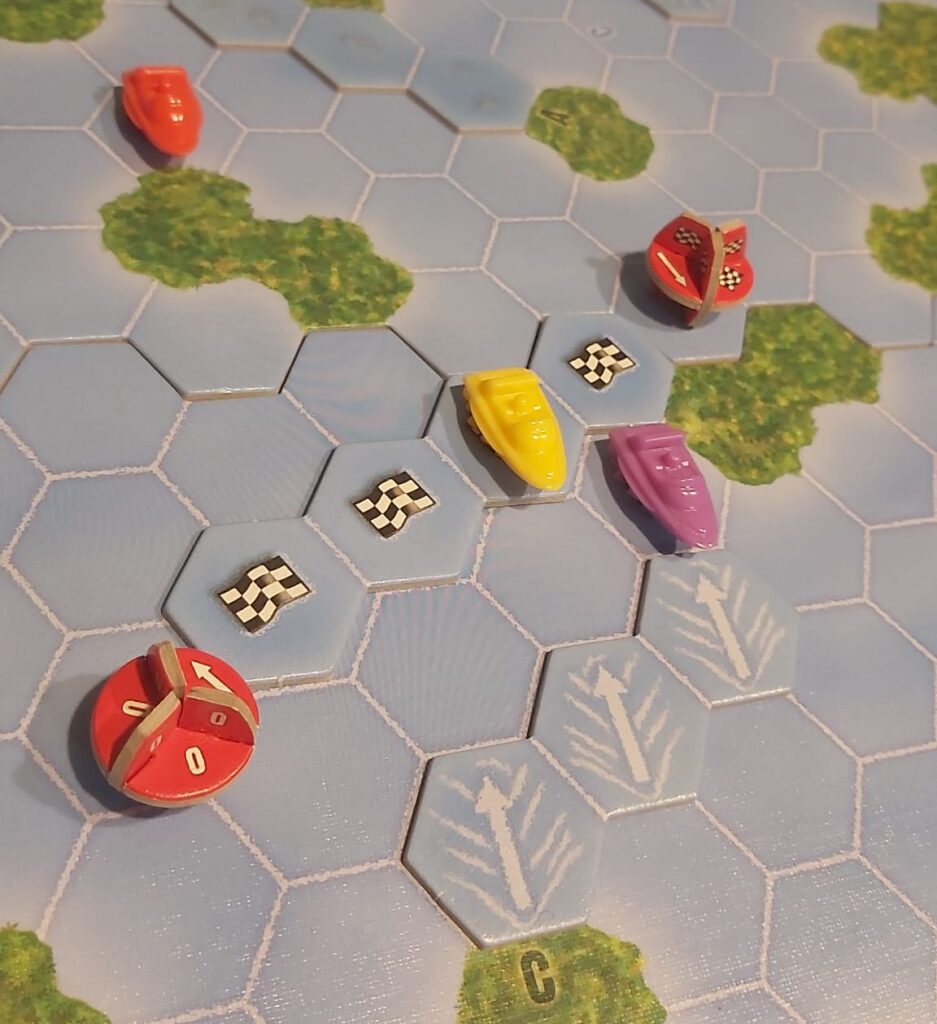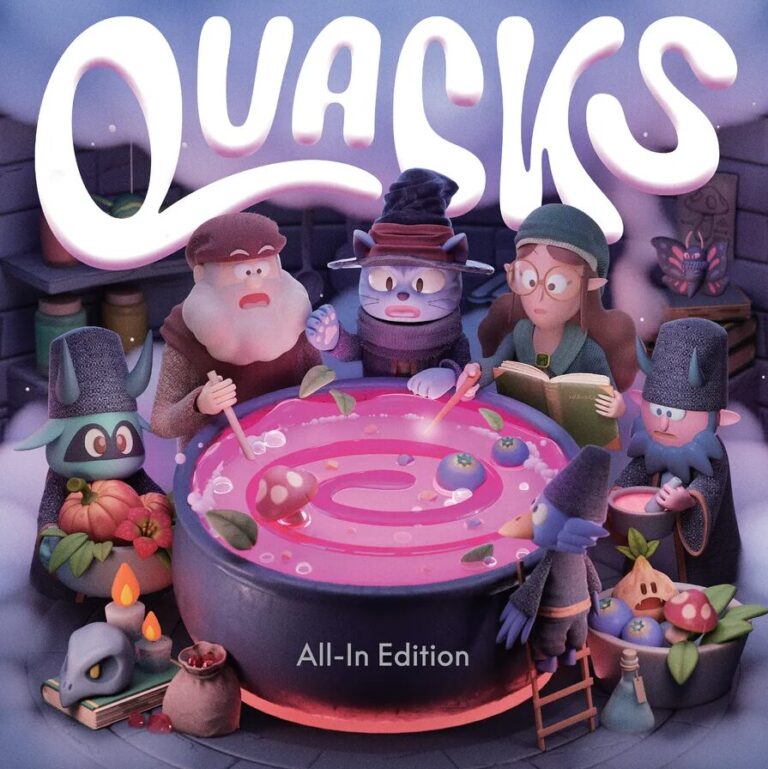
“Hopefully people can see the difference between what we are being accused of and what has transpired”: Rebellion Unplugged’s Duncan Molloy on Joyride plagiarism claims
A successful Kickstarter campaign and favourable reviews for post-apocalyptic car racing game Joyride: Survival of the Fastest have been dampenened by claims of plagiarism from Powerboats designer Corné van Moorsel, who is seeking royalties from publisher Rebellion Unplugged.
That situation has been complicated by the fact that Rebellion Unplugged head and Joyride co-designer Duncan Molloy approached van Moorsel in 2019 about reprinting Powerboats, before changing his mind several months after the pair met up at Spiel Essen that year.
BoardGameWire has covered the situation in detail in this article – but Molloy has also provided extensive answers to BoardGameWire explaining where he believes it is right to draw the line between a new design and development of an existing title, and details the ways he says Powerboats and Joyride differ in their mechanics.
He also admits he worries the dispute will have a knock-on effect on how Joyride is viewed, and outlines his regrets about not acknowledging Joyride’s influences more clearly.
BoardGameWire: There’s clearly a difference of opinion here about whether Joyride is a new design, or something more akin to a development of Powerboats. You’ve mentioned your long experience developing and reprinting games at [former employer] Osprey Games – how do you go about drawing a line between what’s development of an existing title, and what can be considered a new design?
Duncan Molloy: For me the line is drawn when work begins on a project. It’s the difference between “how do I help make the best version of this game” and “how do I make something new”.
The role of a developer is probably most closely akin to an editor – it’s about tweaking and polishing to make sure the final game is the best version of the designer’s intent. In my personal experience with new editions of an existing title there are usually few rule changes, so mechanical development is often (though by no means always) relatively minor. Sometimes something will arise after the initial release that needs addressing, and sometimes the designer will have gone back to the original with changes they want to make. Most of the work involved in a new edition is in art direction and product design.
A new design is just that – a new design. Joyride is a new design. We sat down with a specific design intent (outlined in the BGG dev diary) and worked over several years to create the game we wanted to see. It iterates on some established mechanisms in a unique way and adds entirely new mechanisms while doing so.
You’ve mentioned you regret not communicating with van Moorsel that you wouldn’t be moving forward with licensing Powerboats. What do you say to the BoardGameGeek commenters pointing out that van Moorsel also deserves to be better credited for his design’s importance to Joyride?
I think that’s fair. In my response to Corné on [November 27] I drew a comparison between Clank or Legendary and Dominion, which I no longer think is a good analogue. I don’t think anyone would argue that Clank and Dominion are the same game, but Dominion is well known as the game that effectively invented deckbuilding, and because of that Dominion’s influence on Clank does not feel like something the designers of Clank are trying to hide.
Similarly, I don’t think that anyone who has played both can reasonably argue that Joyride and Powerboats are the same game, but because Powerboats is less well known than Dominion its influence is less immediately obvious. That’s reason enough to make it explicit.
That’s part of the reason I’ve openly acknowledged its influence, along with the influence of many other games, though I could have been more forceful about it. I’d like to reiterate that influence now.

A great many games have a system akin to “higher gear means move more spaces”, but I came across it first in Formula D. Formula D also introduced (to my knowledge) the concept of damaging specific parts of your car if you’re being too reckless. I loved that idea, and we implemented the same concept in a very different way.
Powerboats lets you keep some dice and reroll others to have more control over your speed, which is very slick. I have vivid memories at a cousin’s house as a kid of failing again and again to understand why the tutorial in Gran Turismo was showing a different optimal line to approach a corner depending on my car’s speed. It took my young mind a long time to clock the idea of accelerating through the corner, rather than before or after it. Joyride takes inspiration from Powerboats’ combining “roll to move” with “choose what to reroll”. Joyride uses a two-move system, consisting of one move that was limited by your previous turn (i.e. dice values that you choose to retain) and a separate move that was rolled on your current turn, which gave us a sense of momentum followed by acceleration or deceleration that we were very happy with. Being forced to choose some die values to keep on the approach to a corner, then being faced with the unpredictability of a roll as you start to round the corner, really captured that feeling my younger self had struggled with.
Powerboats uses dice with the values 1-2-3, which Joyride also uses. They work very well at limiting the possibility spread of an outcome, hitting a balance between predictability and randomness. Formula D’s weighted dice achieve a similar effect with a very similar range of outcomes. In an early iteration of Joyride some cars used different combinations of dice (and in some cases differences within specific gears). Ultimately, we limited the asymmetry of the cars to the driver abilities, so that new players could concentrate on the main systems rather than having to hold all the different permutations in their head at once. We settled on 1-2-3 as our baseline as those values mapped well onto a six-sided die, a shape that felt good to roll and easy to place on a dashboard, and we knew from having played Powerboats that it gave a satisfying range of outcomes. Some of the feel of the variable dice still made it into the final game with the Off-Roader’s Momentum ability and the Nitro item.
Any number of racing games use checkpoint-based courses, but Mario Kart Tour (the mobile game version, though some of its tracks have subsequently been added to Mario Kart 8) does some really interesting things with shifting checkpoint and obstacle placement across different laps, completely changing the approach to certain corners. I have also always held on to the joy of the same straight being used on the way to and from a checkpoint in the opening track of the videogame POD Gold, forcing the race leaders to contend with oncoming traffic if they were far enough ahead. Both of these were a big inspiration for having the checkpoints be omni-directional and for designing tracks with wildly different routes from one lap to the next.
Gaslands’ open play area and collision system creates interesting decisions about positioning yourself relative to the other players. It also does a great job of making a game feel like playing with toys. More than anything else the drive to create Joyride was built around wanting the other players’ position on the track to matter, and to centre that interaction to create tension, tactics and fun. Translating the feeling of customisability and player creativity that comes with wargames to a board game was a big part of that. Our final game is wildly different but the playful tone of Gaslands is to my mind one of Joyride’s biggest influences.
We also spent plenty of time on things we didn’t see anywhere else – catch-up mechanics, directional-based collisions, a feeling of heft and physicality, the ability to reverse, an initiative system to reward opportunistic risk-taking. These are all unique to Joyride. As you can tell, I’m incredibly proud of the game. My hope is that as more people play Joyride, they will see it for the original work it is.
Are you concerned there might be hesitancy from other designers in pitching to Rebellion following this, and if not, why not?
I can’t speak for anyone else. We haven’t been accepting unsolicited pitches since early 2020 (with very few exceptions) but anyone working with us now or in the future can expect to be treated professionally and with respect for their authorship.
In 2019 I was the sole employee at Rebellion Unplugged, was trying to wear way too many hats, reached out to a lot of people, and, in this instance, did a poor job of following up. I would hope this incident alone would not sully designers’ views of Rebellion Unplugged. We have grown since then to a team of 6 people who are passionately working on some great board games and RPGs. We are not infallible (I particularly am slower to reply to emails than I would like to admit) but we are professionals with a love and respect for this industry, its history, our peers and our audience.
Hopefully people can see the difference between what we are being accused of and what has transpired.
Do you worry this situation might take some of the shine from Joyride as a design, following its recent plaudits from Shut Up and Sit Down, and its rise to the top of the BGG hotness?
Of course. The game’s rating on BGG immediately dropped from 8.3 to 7.7 and has fallen further since, though it is somewhat reassuring that we have had more positive ratings than negative in the past few days. Unfortunately, the conversation around the design is muddied by people’s views of my poor communication.
I hope my responses to your questions here are taken at face value, and that the years of creative work that many different people have poured into Joyride does not become overshadowed by this situation. Corné did not design Joyride, and my enquiring about the rights to a similar game of his years earlier is not a reason to minimise the people who did. Joyride is very much its own game, and I remain very proud of it.
In hindsight, do you think you could and should have done anything differently through this process regarding Powerboats and van Moorsel, aside from confirming to him in 2019 that you wouldn’t be moving forward with licensing his game?
I do regret not giving Powerboats, and some of our other influences, an acknowledgement in the rulebook. I have openly acknowledged the many influences of Joyride, but doing so in the box itself inarguably carries more weight. We will be putting together an acknowledgements policy on all our games going forward, including any future reprints.





—- Duncan says:
“A great many games have a system akin to “higher gear means move more spaces”, but I came across it first in Formula D.”
But you used the *Powerboats* gear simulation: In each turn players have the option to add or remove one 3-sided die. In *Powerboats*. And now in *Joyride*.
—- Duncan says:
“Powerboats” lets you keep some dice and reroll others to have more control over your speed, which is very slick.”
Yes, the same is in *Joyride* now too.
—- Duncan says:
”Powerboats uses dice with the values 1-2-3, which Joyride also uses.”
Yes, the same too. And the 60 degrees vehicle direction change on the hexagons grid is the same too, to make it complete.
But you say it’s not plagiarism because your intension was to make something new …
—- The course with checkpoints you compare to several (computer) games, while it is much more similar to the *Powerboats* open hexagons grid “lake” with “islands” and 3 “buoys” between start and finish, numbered in order 1, 2 and 3 too.
It’s a real shame this game received the PR storm it did, because it’s one of the most fun games my group has played recently. I’d hate to see it fall through the cracks.
There’s clearly so much love put into it from the art to the mechanics to the accessibility choices.
I hope an amicable resolution is reached somehow, but it’s a shame to see the only other comment at the time of writing is from Corné carrying his same argument over from BGG.
Duncan says his failure is one of communication, but there are still several points he is failing to communicate to your readers as well:
1. The “talks” he was in with Corne about the rights to Powerboats included (according to Corne), asking Corne to send him a copy of Powerboats and its expansion to study its rules set, telling him Rebellion’s reprint would include all of that content, sending him a contract for the reprint (which Corne countered because he didn’t like the initial terms), and telling Corne that he’d get right back to him with the finalized contract Corne had countered with after talking to Rebellion’s lawyers, before going radio silent. This is evidence that his communication did not just “slip through the cracks,” but that cutting off communication was likely deliberate, likely after consulting with Rebellion’s lawyers about what could/couldn’t be recreated in a similar game without legal liability.
2. When Duncan wrote his dev diary for BGG outlining the creation of Joyride, he completely omits these talks transpired, and merely lists Powerboats as an inspiration among many other inspirations (as he does here), none of which are really reflected in Joyride’s final design compared to its obvious overlap with Powerboats. This shows a desire to stretch Joyride’s inspiration to as many different games as possible to defuse the claims that it shares a lot of similarities with Powerboats (as Corne says in his comment here, comparing the checkpoint system with Mario Kart is an absurd stretch when a more obvious comparison of checkpoints on a hexagonal map is obviously Powerboats, i.e. the other hexagonal map-based racing game with user-defined checkpoints that Duncan just so happened to try to buy the license for!). An honest reflection on the creation of a racing game that shares numerous overlapping mechanisms with Powerboats would probably start with an acknowledgement that you offered the designer of Powerboats a contract to reprint his racing game, exchanged dozens of emails with him about the game design and extensively studied its ruleset before making an offer for the reprint. This omission from the published “development diary” shows clear signs that Duncan is trying to distance himself/Rebellion from both the contract offer and inspiration/overlap that Joyride shares with Powerboats.
For what it’s worth, Joyride obviously adds a lot of unique content and ideas above and beyond the systems it drew from Powerboats, and I don’t think it’s wrong or a bad thing to be inspired by another game’s mechanisms, which aren’t copyrightable under current law. However, as numerous designers and publishers have weighed in with on BGG in response to this controversy, when you represent a publisher and enter into contract negotiations with a designer, you can and SHOULD hold yourself to a higher standard than “what can I legally get away with.” If a publisher is interested in and negotiating for a design that was created by an outside designer, they should pay for that design, and if they choose instead to create a similar game that has ANY similarities or overlapping mechanisms, they should offer that designer co-author credit and some form of compensation, full stop. I suspect Rebellion could end this controversy, mend fences with Corne, garner Joyride even more positive buzz with the gaming community, and bolster Rebellion’s reputation with other potential future designers if they offered Corne some modest compensation and “co-author” credit on the game (Corne has pointed out that’s exactly what Uwe Rosenberg and Stronghold Games did with him on Nova Luna, which was initially inspired by Corné’s Habitats but has many more distinct differences — and there wasn’t even any contract negotiation messiness involved in that case!). The fact that Duncan/Rebellion are doubling down on it being a new and wholly original design while touting other inspirations that show no tangible influence on the game, except the obvious overlap with Powerboats, is unfortunate.